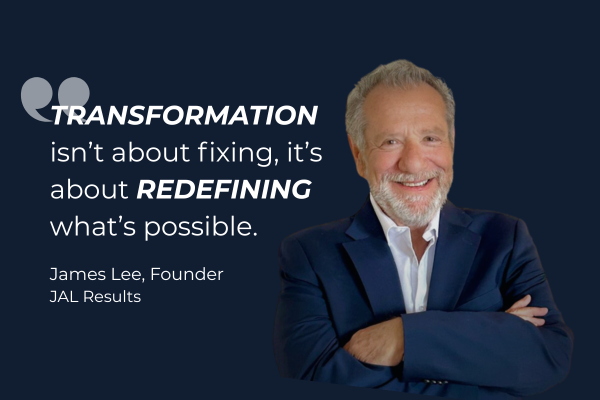By James Lee
At the executive level, performance isn’t just about doing more. It’s about seeing more. More clearly and more strategically.
That’s what transformation makes possible.
When we talk about transformation, we’re not talking about fixing what’s broken, learning a new framework, or working harder. We’re talking about a powerful shift in how you and your teams relate to reality. It’s about uncovering the hidden stories, assumptions, and beliefs that quietly shape your decisions, your culture, and your results.
Once you see those patterns for what they are, not truths, just inherited interpretations, you suddenly have access to new ways of thinking, leading, and performing. That’s when change happens fast. Not gradually, but fundamentally.
What Makes Transformation So Different?
It’s not about improvement. It’s a shift in context. The way you view your role, your challenges, and your opportunities changes. And when that changes, everything else tends to follow.
Here’s what we’ve seen in our work with executives and leadership teams:
- It happens in a moment. A single insight can change everything.
- It goes to the root. You move beyond surface-level fixes and reveal what’s actually driving outcomes.
- It’s empowering. People shift from blame and burnout to responsibility and choice.
- It reveals new paths forward. Possibilities emerge that weren’t visible before.
Let’s bring this to life with some real-world examples:
Transforming Culture Without a Reorg
A mid-sized marketing firm came to us with a problem: siloed teams, missed deadlines, and a culture of finger-pointing. Leadership believed their people just didn’t care.
During a workshop, that belief was surfaced and re-examined. Leaders began to see this wasn’t a fixed truth. It was an assumption they had unknowingly reinforced. As they started listening differently and leading with appreciation, collaboration improved. People stopped protecting turf and started working together. Morale rose, and performance followed.
Moving Forward in a Crowded Market
A startup was struggling to gain traction. Their story was, “The market is too saturated.”
That belief was hiding something deeper: a fear of rejection. Once the team saw it clearly, they took responsibility for their narrative. They reimagined their messaging and approached outreach with new energy and commitment. Within a few months, two major enterprise clients came on board. The market hadn’t changed, but their approach had.
Reenergizing a Sales Team
A regional sales team at a global tech firm had been underperforming for years. Their narrative was, “We’re not the favored region.”
That belief made it easier to hold back. But in transformation coaching, they saw how this mindset was allowing them to avoid full accountability. They made a decision to lead differently and act as if they were the company’s top priority. They created their own internal support structures and raised the bar. Within one quarter, they became the highest-performing region.
When Personal Growth Drives Business Results
Sometimes, the biggest shifts start with a single leader.
- One executive overcame impostor syndrome and began leading with clarity and confidence.
- A seasoned project manager stopped believing he had peaked and stepped into senior leadership.
- A high performer restructured her work life by questioning the belief that slowing down meant losing momentum. Her results improved, along with her health and relationships.
None of these changes were about tactics. They began with seeing clearly and choosing from a new perspective.
Why This Matters for Business
Transformation isn’t abstract. It’s not just personal development. It’s a business strategy.
Companies slow down when their people are stuck in outdated stories, unconscious patterns, and limiting assumptions. But when leaders start operating from clarity, ownership, and perspective, they begin making better decisions, taking stronger actions, and creating a healthier culture.
That’s what transformation enables.
And that’s what we help leaders do.
If you’re ready to have a different kind of conversation about performance, culture, or leadership, we’re here for it.

